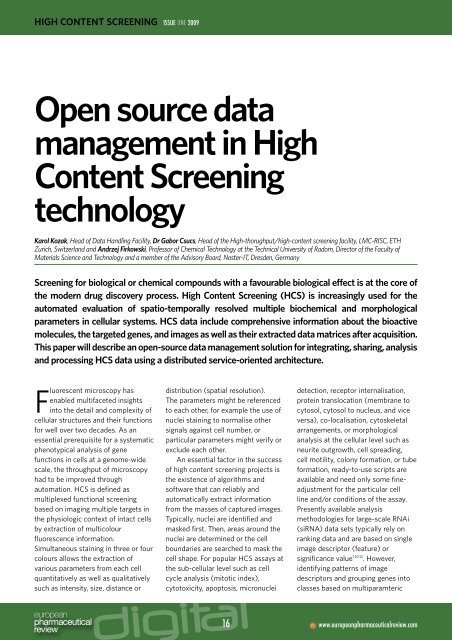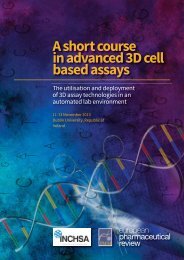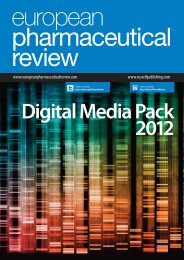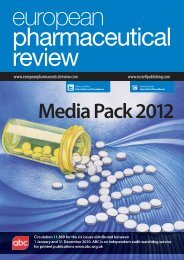Real time PCR - European Pharmaceutical Review
Real time PCR - European Pharmaceutical Review
Real time PCR - European Pharmaceutical Review
You also want an ePaper? Increase the reach of your titles
YUMPU automatically turns print PDFs into web optimized ePapers that Google loves.
HIGH CONTENT SCREENING ISSUE 2009<br />
Open source data<br />
management in High<br />
Content Screening<br />
technology<br />
Karol Kozak, Head of Data Handling Facility, Dr Gabor Csucs, Head of the High-thorughput/high-content screening facility, LMC-RISC, ETH<br />
Zurich, Switzerland and Andrzej Firkowski, Professor of Chemical Technology at the Technical University of Radom, Director of the Faculty of<br />
Materials Science and Technology and a member of the Advisory Board, Noster-IT, Dresden, Germany<br />
Screening for biological or chemical compounds with a favourable biological effect is at the core of<br />
the modern drug discovery process. High Content Screening (HCS) is increasingly used for the<br />
automated evaluation of spatio-temporally resolved multiple biochemical and morphological<br />
parameters in cellular systems. HCS data include comprehensive information about the bioactive<br />
molecules, the targeted genes, and images as well as their extracted data matrices after acquisition.<br />
This paper will describe an open-source data management solution for integrating, sharing, analysis<br />
and processing HCS data using a distributed service-oriented architecture.<br />
Fluorescent microscopy has<br />
enabled multifaceted insights<br />
into the detail and complexity of<br />
cellular structures and their functions<br />
for well over two decades. As an<br />
essential prerequisite for a systematic<br />
phenotypical analysis of gene<br />
functions in cells at a genome-wide<br />
scale, the throughput of microscopy<br />
had to be improved through<br />
automation. HCS is defined as<br />
multiplexed functional screening<br />
based on imaging multiple targets in<br />
the physiologic context of intact cells<br />
by extraction of multicolour<br />
fluorescence information.<br />
Simultaneous staining in three or four<br />
colours allows the extraction of<br />
various parameters from each cell<br />
quantitatively as well as qualitatively<br />
such as intensity, size, distance or<br />
distribution (spatial resolution).<br />
The parameters might be referenced<br />
to each other, for example the use of<br />
nuclei staining to normalise other<br />
signals against cell number, or<br />
particular parameters might verify or<br />
exclude each other.<br />
An essential factor in the success<br />
of high content screening projects is<br />
the existence of algorithms and<br />
software that can reliably and<br />
automatically extract information<br />
from the masses of captured images.<br />
Typically, nuclei are identified and<br />
masked first. Then, areas around the<br />
nuclei are determined or the cell<br />
boundaries are searched to mask the<br />
cell shape. For popular HCS assays at<br />
the sub-cellular level such as cell<br />
cycle analysis (mitotic index),<br />
cytotoxicity, apoptosis, micronuclei<br />
detection, receptor internalisation,<br />
protein translocation (membrane to<br />
cytosol, cytosol to nucleus, and vice<br />
versa), co-localisation, cytoskeletal<br />
arrangements, or morphological<br />
analysis at the cellular level such as<br />
neurite outgrowth, cell spreading,<br />
cell motility, colony formation, or tube<br />
formation, ready-to-use scripts are<br />
available and need only some fineadjustment<br />
for the particular cell<br />
line and/or conditions of the assay.<br />
Presently available analysis<br />
methodologies for large-scale RNAi<br />
(siRNA) data sets typically rely on<br />
ranking data and are based on single<br />
image descriptor (feature) or<br />
significance value 1,10,12 . However,<br />
identifying patterns of image<br />
descriptors and grouping genes into<br />
classes based on multiparamteric<br />
16<br />
www.europeanpharmaceuticalreview.com






